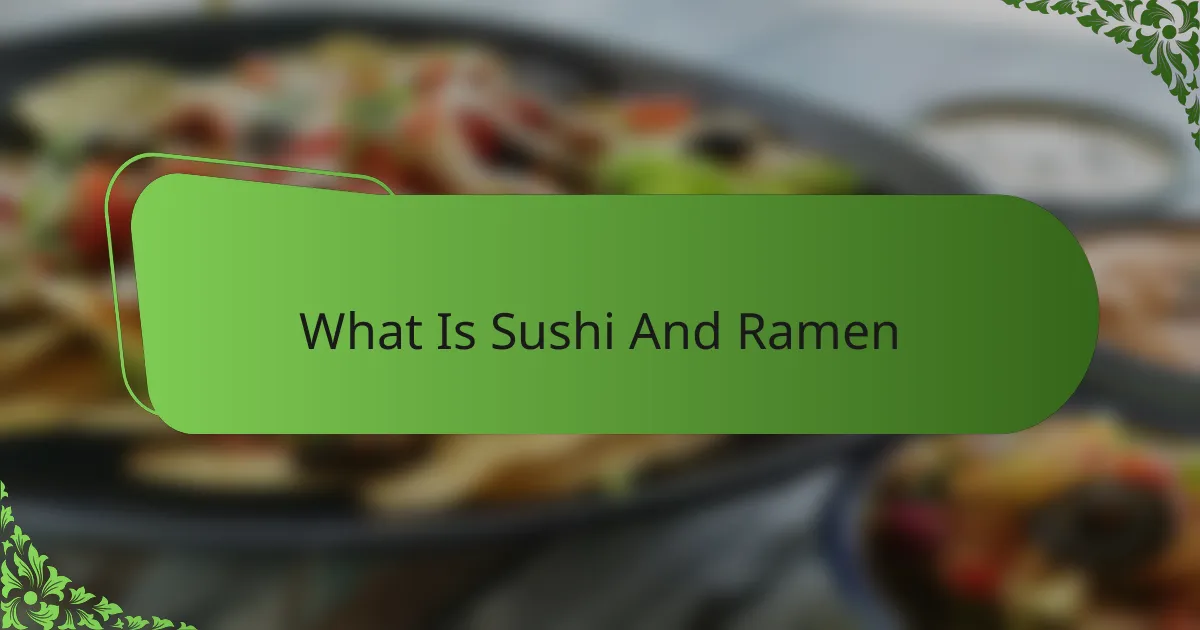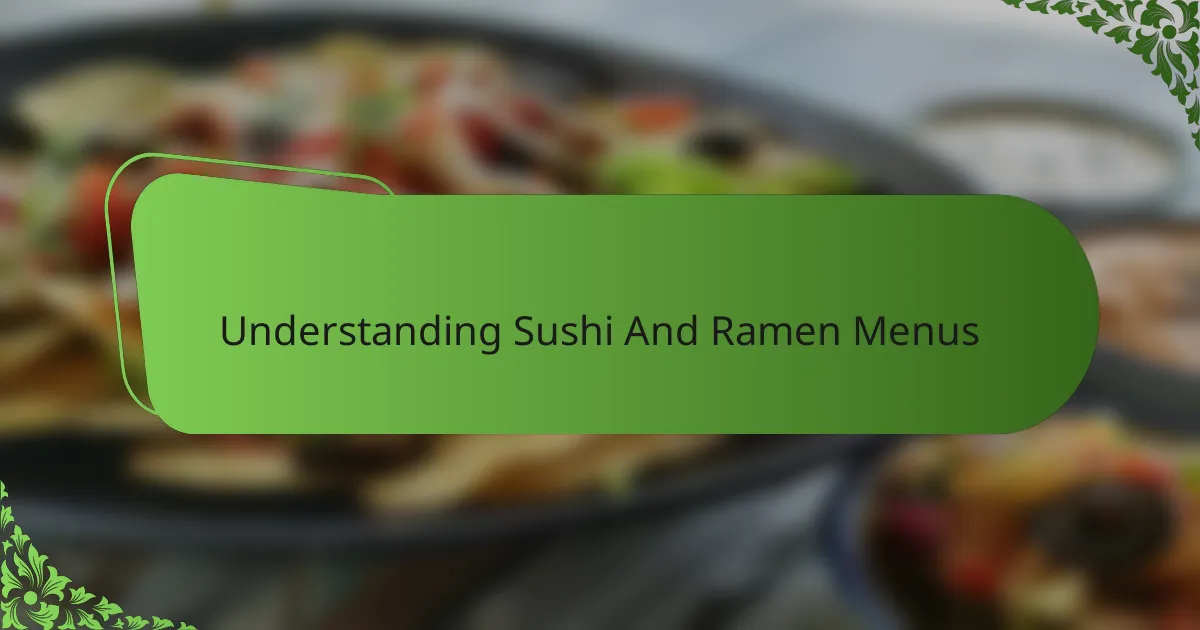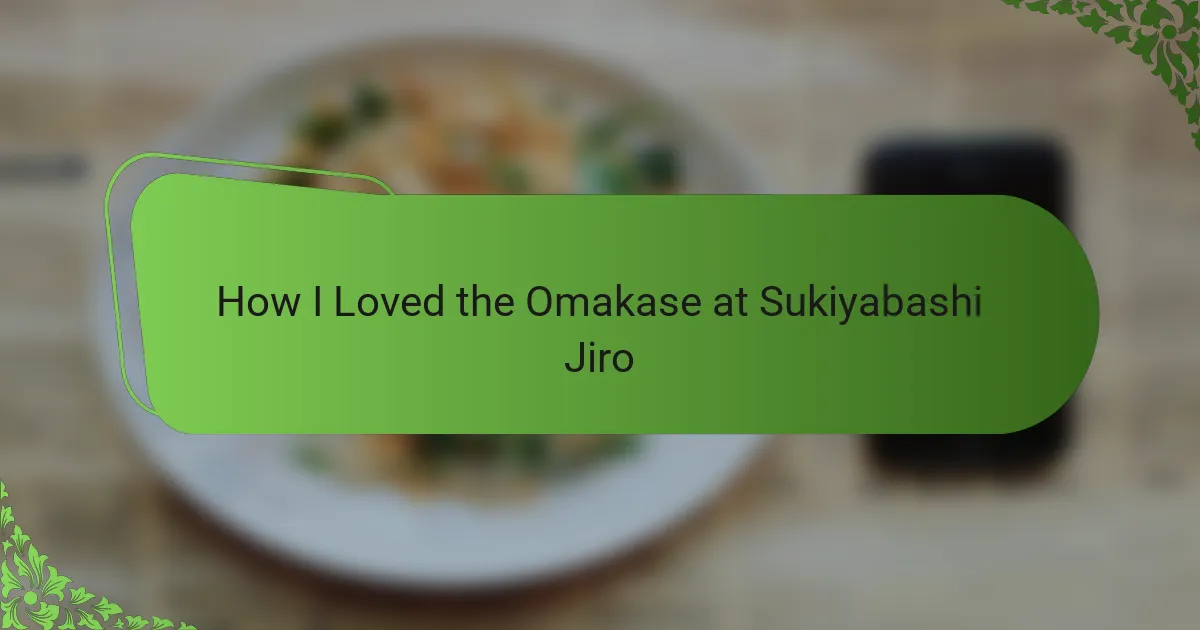Key takeaways
- Sushi is an art form combining quality ingredients like vinegared rice and fresh fish, while ramen offers a comforting balance of flavors with rich broth and noodles.
- Choosing a sushi restaurant should focus on fish freshness, ambiance, passionate chefs, and positive local reviews for an authentic experience.
- Understanding the menu’s terminology and the difference between sushi types and ramen styles enhances the dining experience and makes ordering enjoyable.
- Key dishes like salmon nigiri, tonkotsu ramen, and spicy tuna roll exemplify the delightful balance of flavors and textures that make Japanese cuisine special.

What Is Sushi And Ramen
Sushi, to me, is more than just a dish; it’s an art form combining vinegared rice with fresh fish or vegetables, each piece meticulously crafted. Have you ever noticed how a simple bite of sushi can bring a burst of delicate flavors that linger pleasantly? On the other hand, ramen feels like a warm, comforting hug in a bowl, with its rich broth, springy noodles, and a variety of toppings that tell a story of tradition and innovation. Whenever I taste ramen, I’m reminded of the first time I experienced its complex flavors — so hearty yet balanced — making me appreciate how both sushi and ramen uniquely showcase Japanese culinary mastery.

Choosing The Right Sushi Restaurant
Picking the right sushi restaurant can truly make or break the experience. I’ve found that paying attention to the freshness of the fish is essential—after all, sushi is all about quality ingredients. Have you ever walked out disappointed because the fish tasted off or the rice was too sticky? That’s usually a sign the place isn’t prioritizing authenticity.
Ambiance and service also matter more than I initially thought. A welcoming atmosphere and a chef who seems passionate about their craft can elevate a simple meal into something memorable. When I found a spot where the chef would explain each sushi piece with care, it felt like a personal journey into Japanese culture.
Location and reviews aren’t just for convenience; they often reflect consistency and credibility. I tend to trust places that have glowing feedback from locals rather than just tourists. After all, who knows better what good sushi tastes like, right?

Understanding Sushi And Ramen Menus
Navigating a sushi and ramen menu can sometimes feel overwhelming with so many unfamiliar names and ingredients. I remember my first time staring at a menu full of terms like “nigiri,” “miso,” and “chashu” — it was a bit intimidating. But once I started asking questions and paying attention to descriptions, the menu transformed from confusing to inviting.
Have you ever wondered how chefs choose the perfect set of sushi or ramen items to showcase? Menus often balance traditional favorites with creative twists, reflecting the chef’s personality and the restaurant’s philosophy. From my experience, taking a moment to read the details or even asking the staff for recommendations can reveal hidden gems you might otherwise miss.
Understanding the nuances between sushi types and ramen styles deepens the enjoyment, in my opinion. For instance, knowing that “toro” is fatty tuna adds excitement when you spot it on the sushi menu, while recognizing “shoyu” as soy-based broth helps you anticipate the flavor profile of your ramen bowl. It’s these small insights that make ordering feel like part of the adventure.

Evaluating Food Quality And Freshness
Evaluating the freshness of sushi starts right from that first glance. I’ve learned to trust the vibrant color and firm texture of the fish—dullness or dryness usually signals it’s not at its best. Have you ever noticed how fresh fish almost seems to shimmer on the plate? That subtle glow always assures me I’m in for something special.
When it comes to ramen, the broth is my ultimate freshness test. There’s a depth and clarity I look for, something that tells me the stock was simmered carefully and not rushed. A cloudy or flat-tasting broth often means corners were cut, and that really affects the entire bowl’s flavor.
Rice quality in sushi can’t be overlooked either, in my experience. It should be slightly warm, with a perfect balance between stickiness and individual grains. Have you ever had sushi where the rice felt mushy or too cold? That instantly distracts from the delicate flavors and makes me question the kitchen’s attention to detail.

Describing My Dining Experience
Sitting down at the table, I immediately sensed a harmony in the atmosphere that set the stage for what was to come. The way the sushi was presented caught my eye—each piece looked like a tiny edible masterpiece, and I found myself eager to savor every bite. Have you ever experienced that moment when the visual appeal of food whets your appetite even before the first taste? That anticipation made the first mouthful all the more memorable.
As I moved on to the ramen, the warmth of the bowl in my hands brought a comforting reassurance that this was a meal made with care. The broth greeted me with a depth of flavor that unfolded gradually, while the noodles had just the right springiness—a balance I’ve learned not every place manages to get right. It’s funny how something as simple as a bowl of noodles can evoke such a profound feeling of satisfaction, isn’t it?
Throughout the meal, what stood out most was the subtle interplay of textures and tastes that kept me engaged. From the delicate, buttery softness of the nigiri to the robust, savory punch of the ramen broth, each element told its own story but came together perfectly. Have you ever finished a meal feeling like you’ve been on a little journey? That’s exactly how this experience felt for me—both comforting and exciting in equal measure.

Highlighting Favorite Dishes
One dish that immediately stole my attention was the salmon nigiri. The way the tender, buttery salmon melted against the subtly vinegared rice created a harmony I found irresistible. Have you ever had a bite so simple yet so perfectly balanced that it made you pause and savor the moment? That was exactly how I felt with this dish—pure, unpretentious delight.
Moving on to ramen, the tonkotsu bowl deserves a special mention. Its creamy, rich broth enveloped my senses with warmth that reminded me of a cozy evening at home, while the perfectly cooked noodles added just the right amount of chewiness. I remember thinking, “This is what comfort food should taste like,” and it’s a memory that still lingers.
Lastly, the spicy tuna roll offered a vibrant contrast that kept my palate intrigued. The kick from the chili paired with the freshness of the fish created excitement in every bite. Have you noticed how a well-executed roll can be like a flavor adventure? This one definitely took me on a little thrill ride without overwhelming my taste buds.



